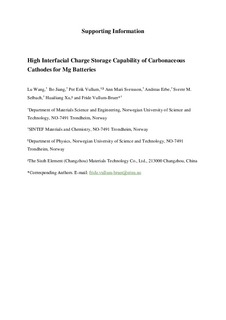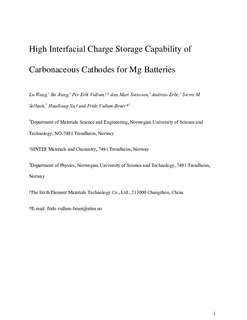| dc.contributor.author | Wang, Lu | |
| dc.contributor.author | Jiang, Bo | |
| dc.contributor.author | Vullum, Per Erik | |
| dc.contributor.author | Svensson, Ann Mari | |
| dc.contributor.author | Erbe, Andreas | |
| dc.contributor.author | Selbach, Sverre Magnus | |
| dc.contributor.author | Xu, Huailiang | |
| dc.contributor.author | Vullum-Bruer, Fride | |
| dc.date.accessioned | 2019-01-05T12:14:37Z | |
| dc.date.available | 2019-01-05T12:14:37Z | |
| dc.date.created | 2018-07-05T12:14:13Z | |
| dc.date.issued | 2018 | |
| dc.identifier.citation | ACS Nano. 2018, 12 (3), 2998-3009. | nb_NO |
| dc.identifier.issn | 1936-0851 | |
| dc.identifier.uri | http://hdl.handle.net/11250/2579320 | |
| dc.description.abstract | A rechargeable Mg battery where the capacity mainly originates from reversible reactions occurring at the electrode/electrolyte interface efficiently avoids the challenge of sluggish Mg intercalation encountered in conventional Mg batteries. The interfacial reactions in a cell based on microwave-exfoliated graphite oxide (MEGO) as the cathode and all phenyl complex (APC) as electrolyte are identified by quantitative kinetics analysis as a combination of diffusion-controlled reactions involving ether solvents (esols) and capacitive processes. During magnesiation, esols in APC electrolytes can significantly affect the electrochemical reactions and charge transfer resistances at the electrode/electrolyte interface and thus govern the charge storage properties of the MEGO cathode. In APC–tetrahydrofuran (THF) electrolyte, MEGO exhibits a reversible capacity of ∼220 mAh g–1 at 10 mA g–1, while a reversible capacity of ∼750 mAh g–1 at 10 mA g–1 was obtained in APC-1,2-dimethoxyethane (DME) electrolyte. The high capacity improvement not only points to the important role of the esols in the APC electrolytes but also presents a Mg battery with high interfacial charge storage capability as a very promising and viable competitor to the conventional intercalation-based batteries. | nb_NO |
| dc.language.iso | eng | nb_NO |
| dc.publisher | American Chemical Society | nb_NO |
| dc.title | High interfacial charge storage capability of carbonaceous cathodes for Mg batteries | nb_NO |
| dc.type | Journal article | nb_NO |
| dc.type | Peer reviewed | nb_NO |
| dc.description.version | acceptedVersion | nb_NO |
| dc.source.pagenumber | 2998-3009 | nb_NO |
| dc.source.volume | 12 | nb_NO |
| dc.source.journal | ACS Nano | nb_NO |
| dc.source.issue | 3 | nb_NO |
| dc.identifier.doi | 10.1021/acsnano.8b00753 | |
| dc.identifier.cristin | 1595877 | |
| dc.description.localcode | © American Chemical Society 2018. This is the authors accepted and refereed manuscript to the article. Locked until 14.3.2019 due to copyright restrictions. | nb_NO |
| cristin.unitcode | 194,66,35,0 | |
| cristin.unitcode | 194,66,20,0 | |
| cristin.unitname | Institutt for materialteknologi | |
| cristin.unitname | Institutt for fysikk | |
| cristin.ispublished | true | |
| cristin.fulltext | postprint | |
| cristin.qualitycode | 1 | |

